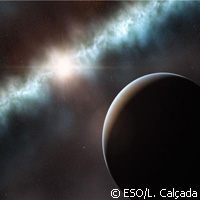The chameleon's cryptic companion
T Chamaeleontis (T Cha), a young star about to form a planetary system, is surrounded by its natal dust disc - and the dust disc sports a gap. An international team of astronomers, funded in part by the EU, has attempted to find out why. Using an innovative approach, the researchers have managed to detect a companion object that may have been sweeping its path. Has T Cha recently hatched a planet? 'Planets form from the discs of material around young stars,' the European Southern Observatory (ESO) explains, 'but the transition from dust disc to planetary system is rapid and few objects are caught during this phase.' At a mere 7 million years of age, T Cha is just embarking on life's long journey, and it seemed a likely candidate for astronomers aiming to catch science's first glimpse of a forming planet in such a transitional disc. It is a star similar to our own Sun, if considerably younger, located in the small southern constellation of Chamaeleon at a distance of approximately 350 light years. 'Earlier studies had shown that T Cha was an excellent target for studying how planetary systems form,' notes Johan Olofsson of the Max Planck Institute for Astronomy in Heidelberg (Germany). 'But this star is quite distant and the full power of the Very Large Telescope Interferometer (VLTI) was needed to resolve very fine details and see what is going on in the dust disc.' So, with the help of ESO's VLTI and the Astronomical Multi-Beam combinER (AMBER) instrument, a team of astronomers from Australia, Chile, France, Germany, the Netherlands, Spain and the US set its sights on T Cha. Between the inner disc, which is delimited by a narrow dusty ring formed by some of the disc material, and the outer part of the disc extending to 1.1 billion kilometres (km) from the star, they found a stretch of dust-free space. 'For us the gap in the dust disc around T Cha was a smoking gun,' says Nuria Huelamo of the Center for Astrobiology at the European Space Astronomy Centre (ESAC) campus in Spain, 'and we asked ourselves: could we be witnessing a companion digging a gap inside its protoplanetary disc?' This close to a shining star, a much fainter companion was not going to be easy to spot. To overcome this difficulty, the team decided to use the NACO instrument of the VLT instead of the AMBER, which is better suited to studying the structure of the inner disc, but would have been less likely to detect a distant companion. The 'Nasmyth Adaptive Optics System (NAOS) - Near-Infrared Imager and Spectrograph (CONICA)' instrument, NACO for short, enables astronomers to reduce the blurring effect of the atmosphere and to obtain particularly sharp images. The team's search was based on a method called 'sparse aperture masking' (SAM). In contrast to VLTI, this is a type of interferometry involving different parts of the mirror of a single telescope, rather than a combination of telescopes. This novel technique is particularly well suited for the detection of dim objects located close to much brighter ones. The combination of NACO, SAM and VLT proved powerful, enabling the researchers to identify the signature of an object located towards the outer edge of the gap, at a distance of about a billion kilometres from the star. The team's findings suggest that the object could be a brown dwarf - or indeed a recently formed planet. 'This is a remarkable joint study that combines two different state-of-the-art instruments at ESO's Paranal Observatory,' comments Dr Huelamo. 'Future observations will allow us to find out more about the companion and the disc, and also understand what fuels the inner dusty disc.' Dr Huelamo and Dr Olofsson, respectively, are the lead authors of two papers presenting the research in the journal Astronomy & Astrophysics. The research was funded, in part, by the PROTOPLANETARY DISKS ('Formation and evolution of planetary systems') project and the DISKEVOL ('Formation and evolution of planetary systems') project, which respectively received Marie Curie Actions grants worth EUR 168,256 and EUR 45,000 under the EU's Seventh Framework Programme.For more information, please visit: European Southern Observatory: http://www.eso.org(opens in new window) DISKEVOL project factsheet on CORDIS, click: here PROTOPLANETARY DISKS project factsheet on CORDIS, click: here Astronomy & Astrophysics:http://www.aanda.org/
Countries
Australia, Chile, Germany, Spain, France, Netherlands, United States



